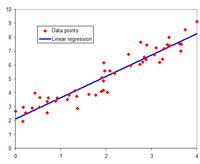
| Part of a series on |
| Regression analysis |
|---|
| Models |
| Estimation |
| Background |
| Part of a series on |
| Machine learning and data mining |
|---|
In statistical modeling, regression analysis is a set of statistical processes for estimating the relationships between a dependent variable (often called the outcome or response variable, or a label in machine learning parlance) and one or more error-free independent variables (often called regressors, predictors, covariates, explanatory variables or features). The most common form of regression analysis is linear regression, in which one finds the line (or a more complex linear combination) that most closely fits the data according to a specific mathematical criterion. For example, the method of ordinary least squares computes the unique line (or hyperplane) that minimizes the sum of squared differences between the true data and that line (or hyperplane). For specific mathematical reasons (see linear regression), this allows the researcher to estimate the conditional expectation (or population average value) of the dependent variable when the independent variables take on a given set of values. Less common forms of regression use slightly different procedures to estimate alternative location parameters (e.g., quantile regression or Necessary Condition Analysis[1]) or estimate the conditional expectation across a broader collection of non-linear models (e.g., nonparametric regression).
Regression analysis is primarily used for two conceptually distinct purposes. First, regression analysis is widely used for prediction and forecasting, where its use has substantial overlap with the field of machine learning. Second, in some situations regression analysis can be used to infer causal relationships between the independent and dependent variables. Importantly, regressions by themselves only reveal relationships between a dependent variable and a collection of independent variables in a fixed dataset. To use regressions for prediction or to infer causal relationships, respectively, a researcher must carefully justify why existing relationships have predictive power for a new context or why a relationship between two variables has a causal interpretation. The latter is especially important when researchers hope to estimate causal relationships using observational data.[2][3]
- ^ Necessary Condition Analysis
- ^ David A. Freedman (27 April 2009). Statistical Models: Theory and Practice. Cambridge University Press. ISBN 978-1-139-47731-4.
- ^ R. Dennis Cook; Sanford Weisberg Criticism and Influence Analysis in Regression, Sociological Methodology, Vol. 13. (1982), pp. 313–361